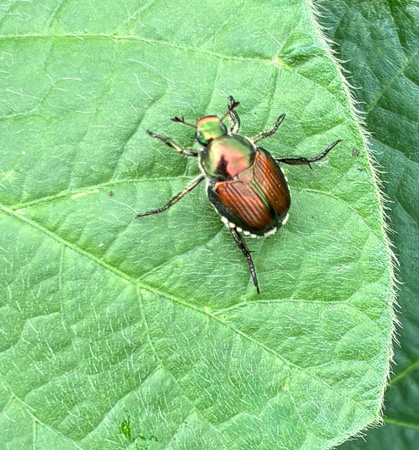Japanese beetles have continued to be a persistent problem in recent years, and 2025 is no exception (Figure 1). The immature stage of this insect is a white grub that typically develops in areas other than the crop fields where adults feed. Like other white grubs, Japanese beetle larvae feed on plant roots and often develop in fields with perennial plant cover like turfgrass or vineyards. This development pattern is important because when the adult beetles emerge, they frequently fly in large numbers to the nearest available food source. Adult Japanese beetles feed on a wide variety of fruits and vegetables, but in row crops, they are most often seen feeding on young succulent soybean leaves or the silks and tassels of corn.

Figure 1. Japanese beetle adult. Photo by Cooper Wyckoff, K-State Research and Extension.
If you notice large numbers of beetles, be sure to scout the entire field. Infestations often appear concentrated on the side of the field closest to where the beetles emerged.
Treatment thresholds if large numbers of beetles are present
- Corn: Treatment may be justified if beetles are clipping silks to less than ½ inch and pollination is just beginning.
- Soybeans: Use thresholds similar to other defoliators. Treatment may be warranted if 50% of the plants are defoliated during vegetative stages or 20–25% during reproductive stages.
Remember, the beetles tend to congregate on the side of the field closest to where the larvae developed.
For more information relative to Japanese beetle management, please refer to K-State’s Insect Management Guides for Corn and Soybeans:
Corn: https://bookstore.ksre.ksu.edu/item/corn-insect-pest-management-2025_MF810
Soybeans: https://bookstore.ksre.ksu.edu/item/soybean-insect-pest-management-2025_MF743
Jeff Whitworth, Extension Entomology Specialist
jwhitwor@ksu.edu
Tags: soybeans insects corn Japanese beetles